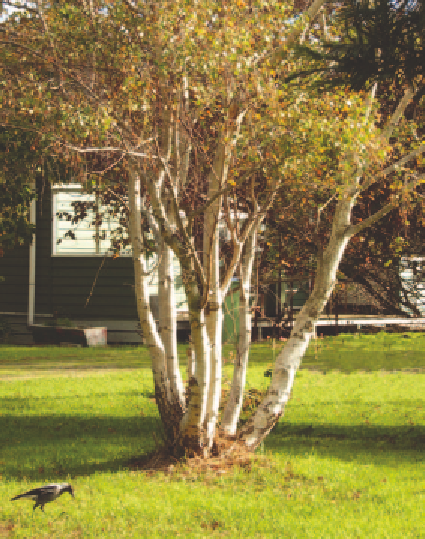Agriculture Reference
In-Depth Information
These days, coppicing is generally used to
show off attractive stems or to retain juvenile
foliage. However, there are still some farmers
who coppice eucalypts in order to grow fence
posts. The dense regrowth from the base of
the plant ensures long, straight growth ideal
for many carpentry needs.
This method is still used to raise selected
apple rootstocks. In spring the stool is
gradually covered with compost allowing the
tips of the new growth to protrude. By the
end of the growing season the slender
regrowth will have developed roots of its own.
They are then harvested and planted out
ready for grafting.
When a young tree has become established at
two to three years old, cut back the main stem
to two to three buds from the ground.
This will force a multiplicity of side growths.
In the case of species with ornamental stems
(see Table 4.15), this may be done every
year or so to retain the juvenile bark
characteristics. Those plants grown for their
juvenile foliage, such as eucalypts, may need
all the stems pruned back every three or four
years. As soon as your plant shows signs of its
middle-aged form of bark or foliage, cut back
the stems to within a few centimeters of the
stool. This will ensure a new era of youth
and beauty.
Figure 4.55
This silver birch was coppiced when only a
few years old to accentuate the beautiful bark.
Essentially there is no trunk and therefore
trees can be made to behave as a shrub. It
entails cutting the central leader to within
one or two buds of the ground creating a
forest of slender side stems.
Coppicing was practised in English forests to
open them to the light, allowing better
pasture for game. Forage from the new
growth of the coppiced plant and the
diversity of herbage that emerged as a result
of increased light conditions, encouraged
deer as well as biodiversity. It is the same
theory used by Indigenous Australians with
their use of fire-stick farming to refresh
grasses and provide pasture for kangaroos
and other marsupials.
Hedges
Hedges can be used as the skeleton of a
successful landscape. They create a basic
framework that can define and enhance
outdoor space. They may provide a backdrop,
a screen or simply a division of one space from

